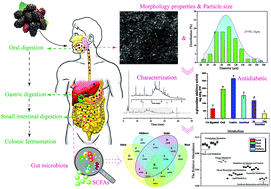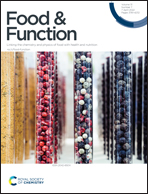A dynamic view on the chemical composition and bioactive properties of mulberry fruit using an in vitro digestion and fermentation model†
Abstract
Mulberry is a kind of fruit rich in nutrients, however, the beneficial effects of mulberry fruits are related not only to the amount consumed, but also to the bioavailability of these nutrients in the organism. Hence, the aim of this study was to evaluate the bioaccessibility of main bioactive compounds from mulberry fruit using an in vitro digestion model, the changes in bioactivities as well as intestinal flora were also investigated. The results showed that the particle size of the mulberry fruit was gradually reduced (from 196.87 to 60.85 μm), as well as the phenolics and carbohydrates were significantly released during the digestion and maximized in the first 15 min in the intestinal phase (1752 ± 2.80 mg GAE per 100 g, DW; 277.402 ± 2.80 mg GE per 100 g, DW, respectively). Meanwhile, the bioaccessibility indices for phenolic compounds and carbohydrates were 55.49% and 84.62%. The antioxidant activity and α-glucosidase inhibitory effect of the mulberry fruit were positively correlated with their total content of released phenolic compounds. And the phenolic compounds (2,4,6-trihydroxybenzoic acid, cyanidin-3-O-glucoside, 3,4-dihydroxybenzoic acid and gallic acid) were the main compounds that inhibit the α-glucosidase activity by binding to its active cavity through hydrogen bonds. In addition, the mulberry fruit undigested fractions could be further fermented by intestinal microorganisms to produce short-chain fatty acids (SCFAs), which decreased the colon pH value (from 5.93 to 4.79) and the Firmicutes/Bacteroidetes ratio which was beneficial for obesity. Our results indicated that the mulberry fruit exhibited good bioactivity during digestion and fermentation, and could be a promising candidate as a dietary source of functional foods.



 Please wait while we load your content...
Please wait while we load your content...